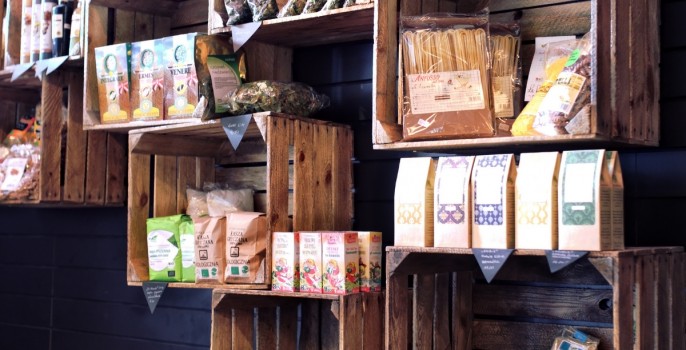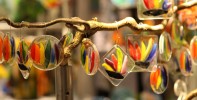I met Molly of Unique Art Pendants through the Etsy forums where she takes time away from her busy shop to offer sage advice to fellow sellers. I interviewed her back in 2011 for my Etsy Tycoons series. Molly joins us again for a guest blog of craft show tips to prepare you for the summer season.
Summer is coming and lots of opportunities for craft shows are coming up. I’ve done plenty of arts and craft shows over the years, so I wanted to share some tips for newcomers and experienced vendors alike.
Prepare
Craft shows can be fun and exciting if you’re mentally and physically prepared. Try to set up your booth at home the day before and take as much time as you need to figure out the best display. Once you have it set up, take a picture with your phone; you’ll be able to refer back to it on the busy morning of the craft show. It’s way less stressful to have a thought-out plan beforehand.
Set up
Arrive as early as possible to set up your booth space. It’s better to have extra time before the event to walk around and meet other vendors. It also ensures you’ll be in your proper space and no one “accidentally” sets up in your space. I’ve seen some dirty tricks from other sellers looking to ditch their unfortunate, awkward booth space.
If you’re in an outdoor booth, set your tent up with the removable side walls attached but rolled up. If it rains, you can quickly unroll the sides to protect your stock instead of running around in the rain trying to attach your sides.
Make sure to weigh down your tent legs. When the wind picks up, the tent’s canopy works like a sail and can pull your tent up and away – or worse, into your neighbor’s pottery booth. You can buy tent weights, but there are also low-cost DIY solutions that work wonders.
Most crafters use E-Z Up tents; they’re easy to use and usually come with sides. You can find them at Sam’s Club during the Spring and Summer, or online. You can also check the local party rental store for E-Z Up tent rentals.
Change
Never forget your change. I always start each show with about $100 in cash: 50 $1’s and 10 $5’s. Rounding your prices to the nearest whole dollar amount can make things easier if you don’t need to charge tax. If you do need to charge sales tax, check with your state to see if you can have the sales tax included with the price. Brittany’s Fixed Pricing Worksheet helps figure out what to pay in tax with whole dollar pricing.
Seller stare-down
Be mindful of your booth setup, and if your position in the booth is approachable to buyers. It’s all psychology, and this is where it’s important. The number one mistake I see sellers make is to face whoever approaches the booth head on. I call it the “seller stare-down.” A seller looking directly at the approaching customer can be very intimidating for some folks, and they’re less likely to stop. This is easily fixed by pivoting your chair 45 to 90 degrees.
A seller looking directly at the approaching customer can be very intimidating for some folks, and they’re less likely to stop.
You can feel out how comfortable a person is by the vibe they give when approaching your booth. Don’t pounce on them like a lion, let them settle in; once they’re in your booth, you can make eye contact, smile, and give your opening line.
Opening line
The opening line! This is important. Like it or not, this is when browsing buyers get their first impression of you. You want to be approachable, but not pushy. If you’re not used to doing craft shows, this can seem awkward at first but you have to just get over it. I use a simple opening line of “Hi there! Feel free to pick anything up or ask any questions” while looking at them and smiling. I leave it at that and don’t say any more unless they give me a cue.
I love this opening line – it lets the buyer know that I see them, gives them permission to touch, and creates a non-pushy opening for conversation. If another person approaches the booth, say it again to the new person. In the rare case that another person approaches right when you’re finished giving your opening line, find something on them to compliment to spread time out and then give your opening line again. You’ll end up saying your opening line a billion times and that’s okay; have a smile on your face every time.
If you have a helper at the show, make sure to explain that stories or chit-chat between you will get cut off if a customer comes into the booth. Don’t finish telling a story to your friend before you give your opening line to a browsing customer. The opening line comes first and takes priority.
Prices
If you don’t have clearly labeled prices, buyers will be turned off. It takes some investment to ask for a price, and many buyers will walk away rather than risk the embarrassment of having to turn an item down. It can also give off a vibe that the seller is “profile pricing” – telling buyers different prices based on their appearance.
Make sure you have a price on everything!
Payment
I accept cash and credit cards only. No checks. Checks are too much of a hassle, and it seems like the only people using checks at modern craft shows are those trying to pass off bad ones.
If you have a smart phone or tablet, get an app to accept credit cards. I’ve found Square easiest – they will send you a free card reader, and the cost is only small percentage of each payment. Paypal also has a similar device. Square can also send you a sticker sheet with a tent card to advertise that you accept credit cards. Make sure that you make a sign, this is very important! You have a better chance of making the sale if buyers know you accept credit cards.
Be prepared for no cell service or a dead battery. Buy some credit card slips from an office supply store. These are a great back up if you’re in a building that prevents cell service. Just fill out the paper slip, then have the customer sign it and include their phone number. When you get home, manually type all the credit card charges into the app. If there’s any problem with the charge, call the customer and make sure you have the info correct.
Business Cards
Put a few small stacks of business cards on your table. It’s up to you to decide what info you want on your business cards. I have my name, city, and website on one side; the other side has a short bio. I don’t include my phone number. That’s strictly a preference – I like all my messages to be through the computer, where I can refer back to them if needed. People will call you if you put your phone number on your cards. Order business cards from sellers on Etsy, or from places like Vistaprint or Moo. You can also buy blanks at an office supply store to print your own.
Product
Take as much product as you can. You can cover your table with tablecloths that reach to the floor to hide extra stock under the tables. If you have a craft that you’re able to do while sitting in your booth, that’s great – but make sure you don’t get too caught up and ignore customers. Leave the books at home. Never, never read a book in your booth. It will make you look bored, closed off, and too busy to approach. This is another huge mistake I see all the time.
Leave the books at home. Never, never read a book in your booth.
Be observant of what the browsing customers do. If you notice customers beelining for the next text after spotting it through your booth, roll down your side wall and make a visual block. Don’t start the show with your sides down – your booth might be the one that customers will beeline to from other booths! Stay alert and adjust things to your advantage.
Food
Craft show days get long. You have to be “on” all day with a peppy smile and a pleasant attitude. It’s exhausting! Make sure to wear comfortable clothes and pack non-messy snacks, drinks and a meal. You’ll most likely be eating in your booth, so bring a compact to make sure you’re not smiling at potential customers with a hunk of lettuce in your teeth. If a buyer comes into your booth, put the food down until there’s no one around again. That way you won’t seem too busy eating for them to buy something.
Vendor apron
Forget the change box, use a vendor apron. I bought a fantastic one on Etsy. They tie at the waist and come in all sorts of patterned fabric to make you look cute and hip. I get compliments on mine at every craft show. Vendor aprons have several pockets for pens and business cards, and a zippered pocket for money. The apron keeps your money on you; there’s no chance of someone grabbing your cash box and running.
If you do use a cash box, always keep it down low in a place where it isn’t easy to grab. Never trust your money with another vendor while you run to the bathroom. Take your money with you to the bathroom.
Bags
Bring bags to put customer purchases in, and make sure to include a business card in each one. I forgot my bags for one craft show, but it was a lucky turn – I had to use the clear cello sleeves I use for my art prints as bags. Every customer was walking around with a clear bag so others could see what they bought. It was like a giant walking commercial for me. So many people came to my booth and said “Oh! Here’s where they are. I’ve seen so many people with these!” I’ll never use anything other than a clear bag again.
I hope these tips have given you some ideas. If you have questions or tips of your own, please post in the comments. Craft shows are great fun, and you can make some money to boot. Good luck!
Get my latest articles straight to your inbox about once a month. Learn how to improve your Etsy shop, boost your sales and discover other sellers from the Etsy community.
6 Responses
Leave a Reply
« USPS Shipping Calculator for 2015 USPS Shipping Calculator for 2016 »








Hi Brittany, Thanks for the great tips.!
I’m about to do my third craft show and have a question about table placement. Is it better to have the table right out in front of your booth so customers can peruse your items as they walk by, or should you try to place the tables and displays around the perimeter of the booth so they have to walk in to get a better look?
Thanks for your help,
Beth
Hi Beth. Great question! I wish I had one solid answer for you but I’ve gotta tell you that it really just depends. I’ve vended at shows where there was such heavy traffic that if you did not have a space for people to “step inside” your booth area, they just got taken in the flow of traffic. There have also been times that I’ve seen people stay clear of entering a booth space where they might get “trapped” – say in a situation where the vendors on either side of you have their tables pushed out and you have yours inset. If you are able to be flexible and prepared for a few different scenarios, that is the best way to go. You will often know your booth placement (corner, mid row, etc.) before the show and that can help narrow down your options. For outdoor events on a hot day, you want to try to offer shade if you are able (you will want it too!). Try walking around a show or two yourself and be aware of the booths you are attracted to or avoid. Have a great market season and thanks for visiting!
Great tips!! Love the clear bag idea & I’m always wondering where to sit/stand in my booth lol!
I’ve been guilty of a few of the things Molly mentions here, especially the staring at my customers straight on. Hope these tips make your next market a grand success!
I have not done a craft show in a long time, but these tips are fabulous. Makes me think about doing one again.
Glad to hear it, LeAllyson!